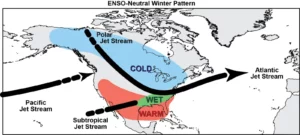GS 1: Geography
The National Oceanic and Atmospheric Administration (NOAA) recently confirmed a shift to ENSO-neutral conditions in the tropical Pacific, marking the conclusion of a mild La Niña phase. The El Niño Southern Oscillation (ENSO) significantly shapes global climate patterns, making an understanding of its phases essential for forecasting weather and climate impacts worldwide.

Overview of ENSO Phases
ENSO comprises three main phases: El Niño, La Niña, and neutral. El Niño is defined by elevated sea surface temperatures in the central and eastern Pacific. In contrast, La Niña is characterized by cooler-than-average temperatures in these regions. Neutral conditions prevail when neither El Niño nor La Niña is dominant, often acting as a transitional phase between the two.
Details of Current ENSO-Neutral Conditions
As of April 2025, sea surface temperatures (SST) in the Niño-3.4 region have stabilized near the average, confirming the onset of neutral conditions. The recorded SST stands at -0.01 degrees Celsius, above the La Niña threshold of -0.5 degrees Celsius. This shift occurred due to warmer waters moving westward and a decline in cooler subsurface water volumes.
Influence on Atmospheric Circulation
ENSO-neutral conditions alter atmospheric dynamics. Surface air pressure in the central Pacific becomes higher than in the western Pacific, creating a pressure gradient. This gradient drives airflow from areas of high pressure to low pressure, impacting surface ocean currents and resulting in a westward water flow.
Impact on Marine Ecosystems
Neutral ENSO conditions promote upwelling of nutrient-rich waters along the South American coastline, fostering robust marine ecosystems and supporting aquaculture. The relatively cooler sea temperatures in the eastern Pacific also contribute to drier conditions in that region.
Future Outlook
Projections suggest that ENSO-neutral conditions are likely to continue through the Northern Hemisphere summer, with a probability exceeding 50% of persisting into autumn. Beyond this timeframe, forecasts grow less certain. There is a 43% chance that neutral conditions will extend into early winter, while a 38% likelihood exists for a La Niña resurgence. The probability of an El Niño event emerging remains low, below 20%.
Historical Perspective on Recent La Niña
The recent La Niña was brief and mild, failing to meet NOAA’s official classification criteria, which require five consecutive three-month periods of below-average temperatures. However, future revisions to climate averages may incorporate this event into historical records.




